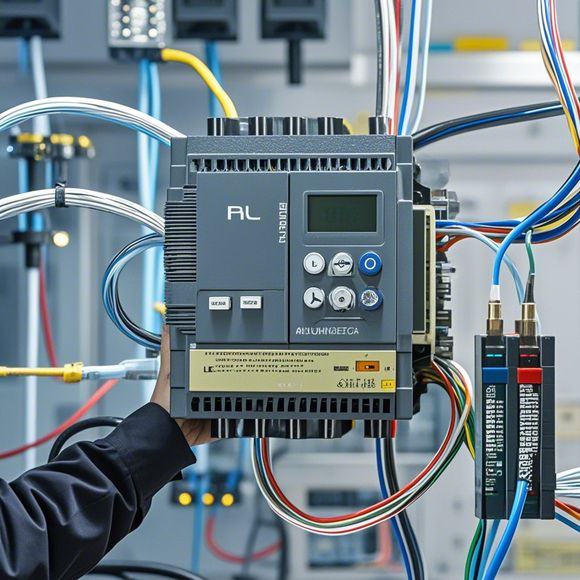PLC Controllers - The Backbone of Modern Automation
PLC controllers are the backbone of modern automation. They play a crucial role in controlling and monitoring industrial processes, allowing for precise and efficient operations. PLCs are designed to work with various types of sensors and actuators, enabling them to detect changes in the environment and respond accordingly. This makes them ideal for applications such as manufacturing, healthcare, and transportation. The ability to integrate with other systems and devices allows for seamless integration into complex workflows, making it easier to achieve goals and optimize performance. In addition, PLC controllers are often equipped with advanced features such as real-time data analysis and predictive maintenance, which can help prevent downtime and minimize costs. Overall, PLC controllers are essential tools for modern automation, providing reliable and efficient control over critical processes.
Introduction:
In the world of manufacturing and industrial automation, there is a constant demand for reliable and efficient systems that can handle complex tasks with precision. One such system that has become increasingly popular in recent years is the Programmable Logic Controller (PLC). These versatile devices are designed to control and monitor industrial processes, making them an essential component of modern manufacturing operations. In this guide, we will delve into the fascinating world of PLC controllers, exploring their working principles, applications, and how they have revolutionized the way we approach automation.
Working Principles:
At its core, a PLC operates on the principle of programmability. Unlike traditional relay-based systems, which rely on physical switches to control circuits, PLCs use software to determine when and how to activate specific components within the system. This allows for greater flexibility and customization, as the logic can be programmed to meet the specific needs of different applications.

One of the key features of PLCs is their ability to communicate with other devices in the system. Through various protocols, such as PROFIBUS, Ethernet, and ISA/PCI, PLCs can connect to sensors, actuators, and other control devices, allowing for real-time monitoring and adjustment of process parameters. This interconnectivity not only enhances efficiency but also enables the system to adapt to changing conditions and optimize performance over time.
Applications:
The versatility of PLCs makes them suitable for a wide range of industrial applications. Some of the most common uses include:
1、Manufacturing Process Control: PLCs are used to automate production lines, ensuring consistent quality and reducing downtime. They can manage complex workflows, including material handling, assembly, and inspection.
2、Industrial Motion Control: By controlling motors and actuators, PLCs enable precise motion control in industries such as textiles, food processing, and packaging.
3、Quality Assurance: PLCs can monitor and control critical parameters in testing and inspection stages, ensuring products meet quality standards.

4、Energy Management: In power generation and distribution systems, PLCs can optimize energy usage by managing loads and preventing overheating or underutilization.
5、Safety Systems: They can be used in safety-critical applications, such as fire suppression systems, to ensure immediate response in case of emergency situations.
6、Healthcare: In healthcare settings, PLCs can be used to manage patient monitoring systems, control equipment, and maintain sterile environments.
7、Agriculture: They can be used in agriculture to automate irrigation systems, fertilizer application, and crop monitoring.
8、Retail: In retail environments, PLCs can be used to manage inventory levels, track sales data, and optimize store layouts.
9、Industrial Maintenance: By monitoring and controlling machinery, PLCs can proactively address issues before they become major problems, reducing downtime and maintenance costs.

10、Industrial Control Systems: PLCs can be integrated into larger industrial control systems, providing a centralized platform for managing multiple subsystems and processes.
Benefits:
The benefits of using PLCs are numerous, both in terms of cost savings and operational efficiency. By automating complex processes, PLCs can reduce labor costs, improve accuracy, and enhance productivity. Additionally, they can provide real-time feedback and alerts, enabling quick responses to changes in the environment or unexpected events.
In conclusion, the Programmable Logic Controller (PLC) is a powerful tool for modern automation, offering unparalleled flexibility and scalability. With its ability to communicate with other devices and control complex systems, PLCs have become an integral part of many industrial operations, enabling companies to operate more efficiently and effectively. Whether you're looking to automate a small shop or run a large factory, investing in PLCs can pay off in terms of reduced costs, improved quality, and increased productivity. So why not consider upgrading your automation strategy today?
Content expansion reading:
Articles related to the knowledge points of this article:
PLC Programming for Automation Control in the Manufacturing Industry
How to Use a PLC Controller for Your Business
PLC (Programmable Logic Controller) Control System Basics
Plumbers Rule! The Role of PLC Controllers in the World of Waterworks
Connecting a PLC Controller to Your Computer
PLC Controllers: A Comprehensive Guide to Understanding Their Prices